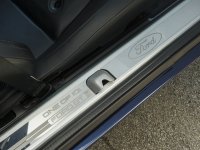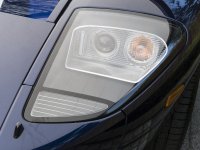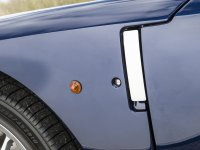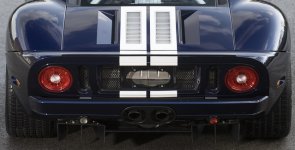I did write a piece for the GT40 Enthusiast Club over here about what we had to do to get the GT legal for sale in the various European countries - it's quite long so get a coffee and make yourself comfortable....
Bringing the 2005 Ford GT to Europe
My involvement with the Ford GT began when I was working for Roush in the UK in 2004. Ford had displayed the Ford GT at the 2002 Detroit Auto Show to a rapturous reception. At the time it was not slated to be sold in Europe but due to the huge interest from European customers Ford of Europe negotiated with Ford in the US to supply a limited number to Europe. The volume settled on was 101 vehicles due, I was told, to Ford records stating that 101 of the original GT40 were built, though I know this figure is not agreed by all.
Due to the lateness of the decision to bring 101 to Europe the US team didn’t have time to make any alterations to the vehicle to allow for the many and various European homologation requirements. So it was agreed that all 101 would be supplied as fully built standard US cars and Ford of Europe would handle the process of making the required changes to make the cars legal and able to be registered in the countries they were sold into.
Roush in the US were the powertrain provider for the GT program and so it was a fairly logical choice to subcontract the European engineering program to Roush in the UK. I was given the Program Manager’s role and we set about working out what we had to change to make the car legal in Europe. Roush also had the contract to look after the sole FoE press car (EU04 CWV) which graced the cover of most of the European Automotive magazines in 2004. We would send a technician with the car to ensure its smooth running in the hands of the press. It didn’t always go well. An enthusiastic Italian journalist didn’t make it through the first chicane at Monza as I recall and there were numerous other repairs and fixes to be done. The press car was the only car we could crawl all over to work out what complied with the various legislation we were faced with to get the 101 cars registered.
We had a small team of engineers at Roush and worked under the Ford Team RS leadership of Jost Capito (now Team Principle at Williams F1) with assistance from various parts of Ford in both Dunton in the UK and Merkenich in Germany.
A few months into the program Team RS took delivery of the yellow single development Ford GT which was used for all testing and also was on the stand at the Geneva motor show in 2005 so we had to keep it looking its best too.
Ford worked closely with the TüV in Germany from their research centre in Merkenich and we had very good assistance from the resident engineer based there throughout the project. It was agreed that all the German cars would be approved through an individual vehicle approval process requiring each car to be signed off against an agreed schedule of modifications. Similarly the UK customer cars were all put through the SVA process. The German TuV inspections were done on site at the Nurburgring while the UK approvals were done one by one at a few different SVA centres.
The target was to do the absolute minimum to make the car legally saleable in each territory. The car was sold through just three dealers in Europe, one in Germany, one in Switzerland and one in the UK as these were the biggest markets.
The changes required boiled down to three basic groups; lighting; security and exhaust.
Lighting – going from red to amber
There were obvious lighting changes that would have to be made – replacing the rear red flashing turn indicator with amber, adding a side repeater, adding a white front marker light and a rear fog light. All the electrical changes were handled in association with Lear who were the supplier of the interior and electrical systems for the Ford GT. We laid out what hardware we needed to change and Lear wrote appropriate software for us to load on to the body control module to make them all work. The lighting changes also drove a new fog lamp switch and associated bezel with indicator lights for front and rear fog lights on. We dealt directly with the suppliers in all cases. The speedometer was already showing mph and kmh but the kmh scale didn’t illuminate with the rest of the gauges so we worked with Autometer to have specific speedometers made with a different fascia illuminating the kmh scale.
The addition of a fog lamp to the rear was dealt with by mounting a circular Hella unit under the rear bumper and this was matched on the opposite side of the car with a reverse lamp as we had reallocated the US reverse lights which are in the centre of the tail lamp assemblies to be our new amber turn indicators. A unique pair of bezels were designed in house at Roush and these were mounted
Security – that “Clarkson” issue
Less obvious than the lighting requirements was that the remote key fob to unlock the car operated on a US frequency which according to the letter of the law had to be different for the EU. In changing the key fob remote to an EU frequency Ford took the opportunity to revise the whole alarm and security system on the car and directed us to work with Cobra as their chosen partner on this. The intention was to achieve the best Thatcham group rating for insurance, though I’m not sure this was ever a factor for customers in reality.
Cobra set out the plan to replace the key fob for a European frequency system and to add a microwave sensor to sense movement in the car and also to add a tilt sensor that would trigger the alarm if the car was lifted in any way. In parallel with the alarm a tracker was specified that was the most secure type at the time with separate driver cards that the owner was advised to keep separate from the keys. This would alert Cobra if the car was driven without the card being in the car.
The hardware was installed in the one development GT we had and tested to confirm it functioned as planned. All was ok until someone at Ford directed that we had to submit the car for Electro Magnetic Compatibility (EMC) tests at MIRA to confirm that the whole package passed the Ford standards for EMC. The principle is that if the car experiences any radio frequencies from external sources it doesn’t incorrectly trigger the alarm or behave unexpectedly. Cobra didn’t think this was necessary but the customer is always right so we all went along with the plan.
I drove the development car up to MIRA and left it in their capable hands for testing for a few days. After a couple of days they called us and advised that the alarm was incorrectly triggering at a certain frequency and they said it was the tilt sensor causing the problem. Cobra were surprised as they’ve been using this sensor for years with no issues. The only other tilt sensor they had was a smaller unit used on motorcycle installations but they hadn’t used it with the alarm module we were using. The decision was made to send it to MIRA and they’d give it a try so that was done and the result was an improvement though it still didn’t pass the Ford test. It was deemed acceptable and so that was the security installation signed off.
Fast forward to the point at which the first cars were being converted and delivered to customers. Ford were extremely keen to get Jeremy Clarkson’s car to him as he had been very vocal about having to wait to get his car having driven the prototype back in late 2003. Within a week or two Jeremy started reporting that the alarm was going off without any apparent reason. Initially we assumed user error as he had also struggled with the concept of a separate driver’s card for the tracker which he routinely forgot to take in the car resulting in a call from Cobra as his tracker had alerted them. It became clear though that the alarm issue was a genuine one and so Ford took the car back from him (and gave him his money back) for us to investigate what was going on.
It took a few weeks of testing with all sorts of circumstances and situations to get the alarm to false trigger and it eventually turned out to be the tilt sensor changing resistance at a particular rate due to cool down or heat up setting the alarm off. This meant going back though our notes and taking to MIRA again about the issues they’d found in the EMC lab – after discussions it became apparent that the blame laid on the tilt sensor wasn’t actually true – what was actually happening was that the wiring for the sensor was acting as an antenna and transmitting the frequency into the alarm module and exciting a circuit on the board for ultrasonic sensors which we were not even using in this installation. So the fix was to go back to the original tilt sensor that Cobra suggested and as an extra precaution the ultrasonic circuit was depopulated from the alarm module. I think it’s safe to say that had we gone with Cobra’s recommended hardware and not put the car in for EMC testing we’d never have had a problem but hindsight’s a wonderful thing…
After Jeremy got his car back he took it down to the South of France for the Millau Bridge episode of Top Gear – I had a call from the Ford PR contact on the Sunday after filming as Jeremy had called him to say how glad he was that he’d had the car back. He wrote an article in the Telegraph shortly afterwards to say it was so good that it was the only car he’d bought twice.
The Cobra key fob that came as part of the package was felt to be rather bland and not very “supercar”. Ignoring the fact that the US cars got the same four button fob that Ford have used for ages in the UK on all vehicles Ford in Europe decided that a sexy new fob casing should be made to house the Cobra internals – if you watch the Top Gear episode when Jeremy first got the car he has a big aluminium fob on the key ring. This was a part made in a bit of a hurry (timing again was against us) in order to be ready for when Jeremy got his car, one of the fixing screws for the internals had contacted the battery circuit and drained the power so that idea was promptly parked and we reverted to boring but reliable Cobra fob.
The moral of all the issues with Jeremy’s car was that you probably shouldn’t rush to get the first car to the most vocal journalist in the UK when you haven’t really had time to double check everything.
Exhaust - It’s just too loud
The biggest mechanical challenge was exhaust sound levels. The US noise levels were significantly above the 74dB required by the TüV. The noise levels are measured in a drive-by situation with a very specific road surface and microphones placed at specified points along the surface. The vehicle under test has to enter the test area at a specific speed and accelerate at wide open throttle and leave the test area at or above a specified speed. Ford have their own TüV approved noise test facility in Cologne, Germany but we set-up a simulation at Dunton for convenience to find out how far away we were from 74dB. The answer was a long way off. I seem to recall the first result we got was 89dB which is a million miles away given that the decibel scale is logarithmic.
The design of the exhaust on the GT is pretty compact. Being mid-engined the exhaust manifolds finish pretty much in line with the centre of the rear wheel so the package space left for the catalysts and the muffler mean they are quite compact. The car has a single muffler box with two inlets and two outlets. Inside there are a series of baffles and chambers which do their best to make the exhaust gases work hard to exit and use up as much of their energy (and therefore sound) as they can before leaving the short tailpipes.
We had no opportunity to enlarge the muffler as there simply wasn’t space to do grow it into. So we were left with internal changes to get down to the required figures.
We initially worked with Proto-Technic who had developed the exhaust system on the Mclaren SLR which also had a few package challenges. They built up a CAD model, ran it through various computational fluid dynamics simulations and built a system that should have given us a good shot at getting the noise down. This was in February and there was snow on the ground in Cologne so we went to Nardo in Italy where they had approved noise test facilities and a slightly warmer temperature. Unfortunately the expected improvements from the internal modifications didn’t translate into significantly lower driveby numbers.
We were sitting in the workshop at Nardo discussing ideas and so we decided to try something just to prove a point. Where the catalyst outlets join the muffler there is a three-bolt triangular flange. We drilled out a sheet of steel with a lot of holes, like a crude tea-strainer and sandwiched it between the two flanges. This seemed to shut down the muffler in a big way – enough that we believed it would scrape through the test. Obviously the tea-strainer would increase the back-pressure in the system significantly but we only needed it to be in place when we were going through the noise test, so by putting it in place of a butterfly exhaust valve we were able to activate it when we needed it. To my knowledge this was the first (and possibly last) application of an active exhaust valve with a perforated butterfly valve. It did the job and we squeezed through the noise test witnessed by TüV in Cologne a few weeks later. It meant employing a controller that was fed vehicle speed and engine speed and when operating within a very fine window the valve was closed momentarily. Enough to pass the test but not so much as to upset the running of the car. We had the controller built by Proto-Technik and used existing parts from Jaguar and Aston Martin (owned by Ford at the time) for the vacuum reservoir, pump and solenoid.
To make the final bit of difference we ordered the component parts of a stock muffler from Tenneco and Capricorn in Stuttgart then built the muffler up with extra e-glass sound deadening between the inner and outer skins and also in the tailpipe.
The subsequent cost of the muffler and control system meant that we only fitted it to mainland European cars. The UK Individual Vehicle Approval (IVA) process didn’t need it to get through the static test.
Ironically most customers switch the stock muffler out because it’s a bit too quiet anyway.
Fortunately exhaust emissions were similar enough that the US catalysts were acceptable for the standards required in Germany at the time so apart from having to do witness tests in the Ford Emission laboratories we didn’t have to make any changes to the car.
Nurburgring – home for a few months
Part of Ford’s requirements when setting out the scope of the project to convert the 101 cars was that it should be carried out in a location where there was no other work being done – a dedicated facility so that they could bring journalists and customers to show them their cars. Roush UK HQ in Brentwood was definitely not suitable, too busy and not enough free space. We had been talking with Capricorn prior to the project and they had just had a new test facility completed at the Nurburgring. It fit the bill for many reasons. Firstly the cars coming in from the US could arrive via Bremerhaven (an established and regular shipping route into Europe) then be trucked down. The facility itself had a huge parking area along with a fuel station on site. Inside the building were offices and a workshop with four two-post lifts, a stores area and accommodation for five people so we could live and work in the same place which worked out really well. We set-up a team of technicians who would rotate roughly every three weeks so we always had a team on site. You couldn’t really have wished for a better location or facility for this type of job and being brand new it was all immaculate.
The conversion project started around April 2005 and ran until September that year. The supply of vehicles from the US wasn’t very consistent and so a few cars ended up being dealt with in Brentwood at the very end. Each car took one man around 2 to 3 days to convert so it was pretty time consuming – the electrical work being the longest part of the job. All wiring modifications had to be soldered and protected and at the end of the process each car was driven over a short route to check for squeaks or rattles. Fortunately these were few and far between. Virtually everything was done on site – the only work outside really was the rear bumper which had to be machined to accept the rear fog and reverse lamps. This was done at one of Capricorn’s other facilities in Düsseldorf. As soon as cars arrived at the ‘ring we’d remove the rear bumpers and these would head off in batches to be modified and then reunited with the cars a few days later.
We weren’t involved in the process of allocating cars to European customers, this was handled between the various National Sales Companies (Ford of France, Ford of Britain, etc) and Ford of Europe itself.
Dealers – customer focus
At the outset of the program Ford decided that due to the small number of cars it wasn’t feasible to use the full Ford dealership network to handle them. It was planned to use just three dealers, one in the UK, one in Germany and one in Switzerland as these three markets accounted for the bulk of customer allocations. The German and Swiss dealers were already Premier Automotive Group dealers handling Aston Martin and Jaguar products so the GT was not too much of a deviation from the norm for them. The plan for the UK was to use Dagenham Motors in Edgeware Road which was part of the Ford owned dealer group. However the tricky location and the fact that they weren’t really set up to deal with low-volume sportscar customers meant that we convinced them to assign Roush in Brentwood as a Ford dealer purely for the purposes of handling the servicing, warranty and repair of GTs as this was now the knowledge centre in Europe for the cars.
As a result my job went from managing the engineering of the project to dealing with the customer facing side of the business. We had a very small team and managed all the customer handovers and any subsequent servicing or other issues.
GT101 – the story continues
My long association with the Ford GT meant that when the cars were in customer hands I was regularly contacted by owners, prospective buyers and sellers about all and every issue relating to the GT. My job in Brentwood was limited to service and repair of GTs and was only a part of my daily tasks. As time wore on it became less of a key role and I was spending more time working on a variety of other projects including the introduction of the Mountune road car upgrade projects and delivering the powertrain upgrades for Ford on their own RS500 Focus program. GTs never left me though and I was routinely asked to help with issues or sales of GTs and it led me to believe there was enough of a business looking after GT owners’ needs to establish a separate business. So that’s what I did at the end of 2013 and we’re now over eight years in and still working on these fabulous cars every day.





